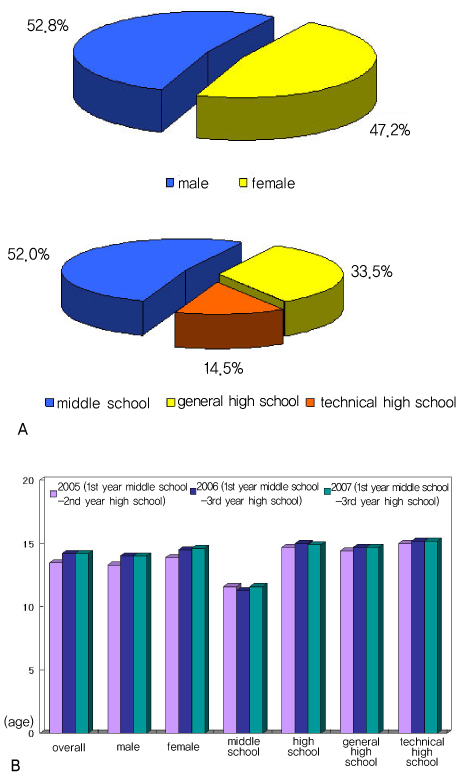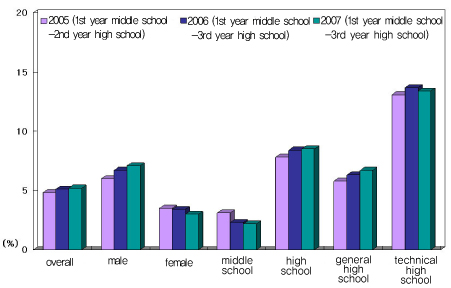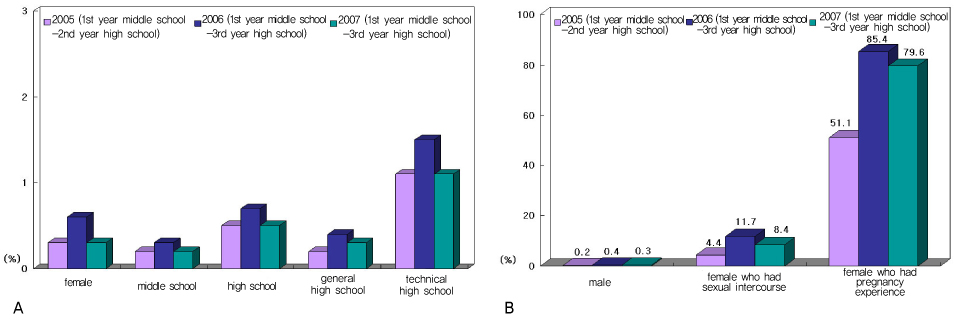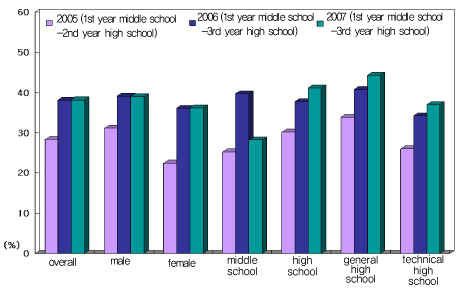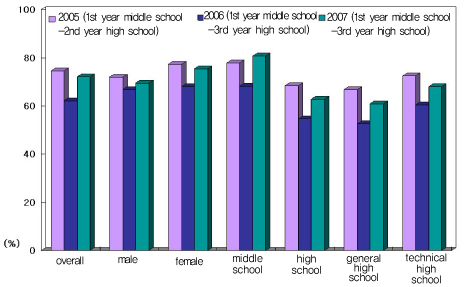Korean J Obstet Gynecol.
2010 Jun;53(6):512-519. 10.5468/kjog.2010.53.6.512.
A survey on the sexual behavior of adolescents in South Korea: The third survey in 2007
- Affiliations
-
- 1Department of Obstetrics and Gynecology, Soonchunhyang University College of Medicine, Seoul, Korea. kychoi@hosp.sch.ac.kr
- KMID: 2273891
- DOI: http://doi.org/10.5468/kjog.2010.53.6.512
Abstract
OBJECTIVE
The survey was conducted to improve the health of Korean adolescents and to prepare adequate teaching programs by investigating their sexual behavior.
METHODS
The participants of the survey was 80,000 middle and high school students aged 13 to 18. The survey was conducted from September 1st, 2007 to September 22nd, 2007.
RESULTS
78,834 students were surveyed and 74,698 (94.8%) students responded the survey. 35,232 (47.2%) of respondents were male students and 39,466 (52.8%) of respondents were female students. 38,820 (52.0%) of respondents were middle school students, 25,051 (33.5%) of respondents were high school students and 10,827 (14.5%) of respondents were technical high school students. 5.2% of respondents experienced sexual intercourse. The average age of the first sexual intercourse was 14.2 years old. 1.0% of respondents had a sexual intercourse before they enter the middle school. The pregnancy rate was 0.3%. Among respondents who experienced sexual intercourse, the rate of the use of contraceptive methods was 38.2%. The rate of using inappropriate contraceptive methods was 21.6%. The average age of a first wet dream for boys was 13.2 years old. The average age of menarche for girls was 12.4 year old. The rate of respondents who had a sex education was 72.2%.
CONCLUSION
The average age of the first wet dream and menarche had been decreased. The average age of the first sex experience among adolescents had been decreased. The rate of adolescents who experienced a sexual intercourse was increased. However, the rate of using reliable contraceptive methods was very low. Therefore, adequate sex educations including effective contraceptive methods needs to be conducted to prevent unwanted pregnancy of adolescents.
Keyword
MeSH Terms
Figure
Cited by 2 articles
-
A Study on Knowledge, Attitudes, and Need for Sex Education in High School Students
Ya Ki Yang
Korean J Women Health Nurs. 2012;18(3):159-169. doi: 10.4069/kjwhn.2012.18.3.159.The attitudes of Korean physicians toward emergency contraceptive pills: regarding women's access and rescheduling
Eun Sil Lee, Chong A Lee, Jee Hee Lee, Bo Ra Park, Imsoon Lee
Obstet Gynecol Sci. 2019;62(3):173-178. doi: 10.5468/ogs.2019.62.3.173.
Reference
-
1. Han SH, Lee MS, Lee SH. A study on the sexual behaviors and its related factors of high school students in Seoul area. J Korean Soc Health Educ Promot. 2000. 17:19–39.2. Kim SJ, Kim IO. The effect of video and discussion-based intervention on the adolescents knowledge and attitude toward sexuality. Journal of Korean Health Study Association. 2004. 30:85–95.3. Atwater E. Adolescence. 1992. 3rd ed. Englewood Cliffs, NJ: Prentice Hall.4. Rodriquez C Jr, Moore NB. Perceptions of pregnant/parenting teens: reframing issues for an integrated approach to pregnancy problems. Adolescence. 1995. 30:685–706.5. The 3rd Korea Youth Risk Behavior Web-based Survey, 2007, Korea Centers for Disease Control and Prevention. Korea Centers for Disease Control and Prevention [Internet]. 2010. cited 2010 Apr 2. Available from: http://healthy1318.cdc.go.kr.6. Cha ES. A Study on knowledge, attitude and behavior in relation to sexuality of the middle school students. J Korean Soc Sch Health. 1999. 12:357–375.7. Kim JC. Research on sexual awareness and investigation science on circumstances of teenagers [dissertation]. 2000. Asan: Soonchunhyang Univ.8. Jee HK, Lee KH, Min BK. A relationship between the problem behavior patterns and the sexual curiosity of student adolescents and deliquent adolescents. J Korean Neuropsychiatr Assoc. 1986. 25:418–430.9. Facts and figures on the adolescents contacting harmful environments. Ministry of health & welfare [Internet]. 2002. cited 2010 Apr 2. Seoul: Ministry of health & welfare;Available from: http://www.mohw.go.kr/.10. Johnson J. Sexually transmitted diseases in adolescents. Prim Care. 1987. 14:101–120.11. Jakobsen R, Rise J, Aas H, Anderssen N. Noncoital sexual interactions and problem behaviour among young adolescents: the Norwegian Longitudinal Health Behaviour Study. J Adolesc. 1997. 20:71–83.12. Gong SK. Developement of comprehensive sexuality education model for schools in Korea. Planned Population Federation of Korea. 2000. 8:71–90.13. Kim MJ. Analysis of variables related to age at first adolescent pregnancy. Korean J Youth Stud. 2002. 9:71–85.14. Abrahamse AF, Morrison PA, Waite LJ. Teenagers willing to consider single parenthood: who is at greatest risk? Fam Plann Perspect. 1988. 20:13–18.15. Hanson SL, Myers DE, Ginsburg AL. The role of responsibility and knowledge in reducing teenage out-of-wedlock childbearing. J Marriage Fam. 1987. 49:241–256.16. Olson CF, Worobey J. Perceived mother-daughter relations in a pregnant and nonpregnant adolescent sample. Adolescence. 1984. 19:781–794.17. Ralph N, Lochman J, Thomas T. Psychosocial characteristics of pregnant and nulliparous adolescents. Adolescence. 1984. 19:283–294.18. Spear HJ. Teenage Pregnancy: The experiences of adolescent females who attended an alternative school [dissertation]. 1997. Charlottesville: Virginia Univ..19. Santelli JS, Beilenson P. Risk factors for adolescent sexual behavior, fertility, and sexually transmitted diseases. J Sch Health. 1992. 62:271–279.20. Lee IS, Park EH, Lee JJ. A survey of attitude toward sex of unmarried women in South Korea. Korean J Obstet Gynecol. 2006. 49:157–167.
- Full Text Links
- Actions
-
Cited
- CITED
-
- Close
- Share
- Similar articles
-
- Substance Use and Sexual Behaviors of Adolescents in Multicultural Families in Korea
- Rates and Methods of Contraception Among Korean Adolescents from 2007 to 2009
- The Impact Factors on Mental Health of Male and Female Korean Adolescents - Focusing on Sexual Experience: Analyzing Data from the 11th Korean Youth Risk Behavior Web-Based Survey
- Suicidal Behaviors of Culturally Diverse Adolescents with Sexual Experience: Using Date from the 10~12th Korean Youth Risk Behavior Web-based Survey
- Factors Affecting Contraceptive Use among Adolescent Girls in South Korea

